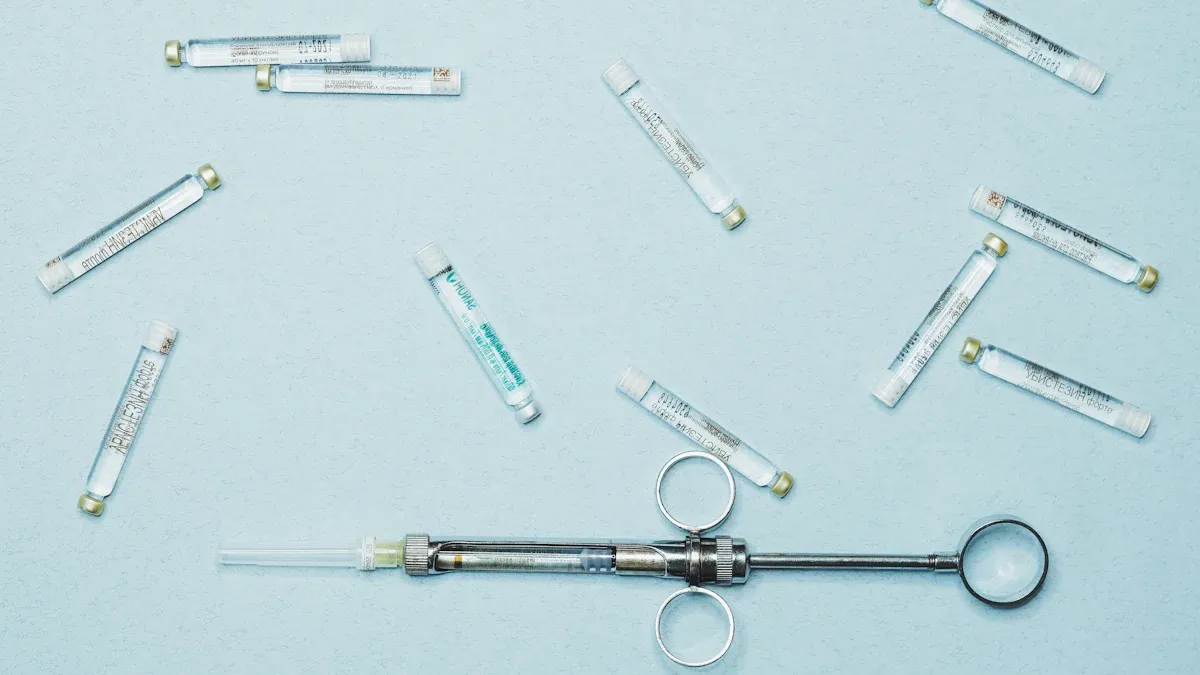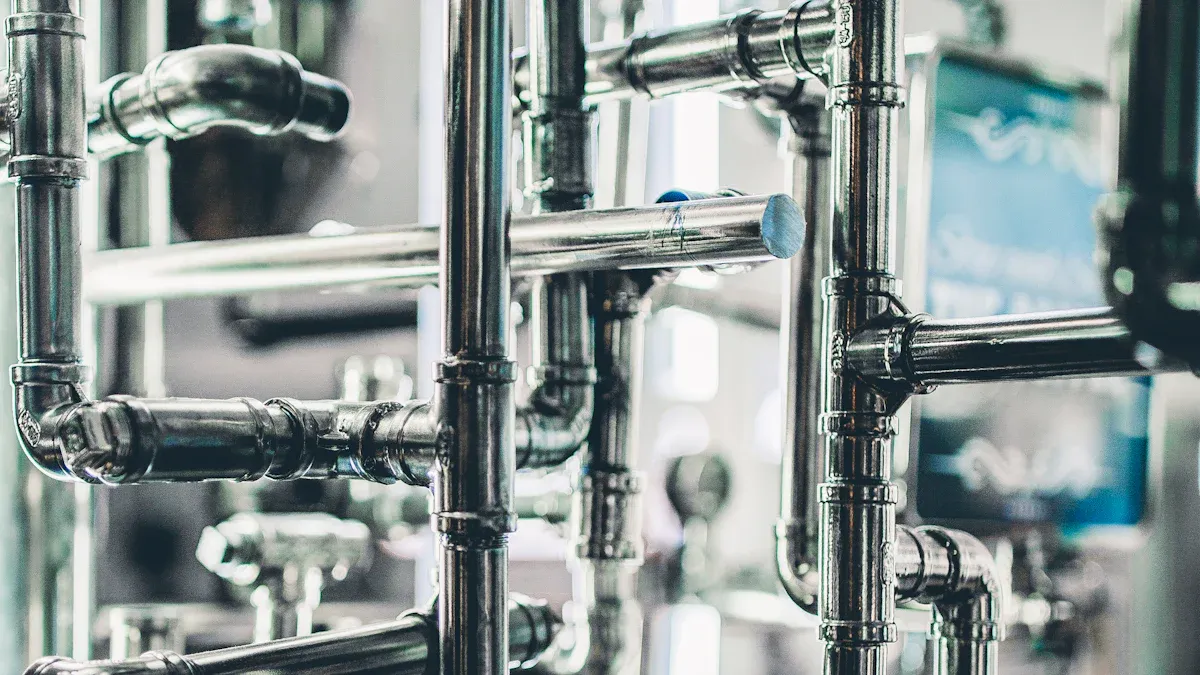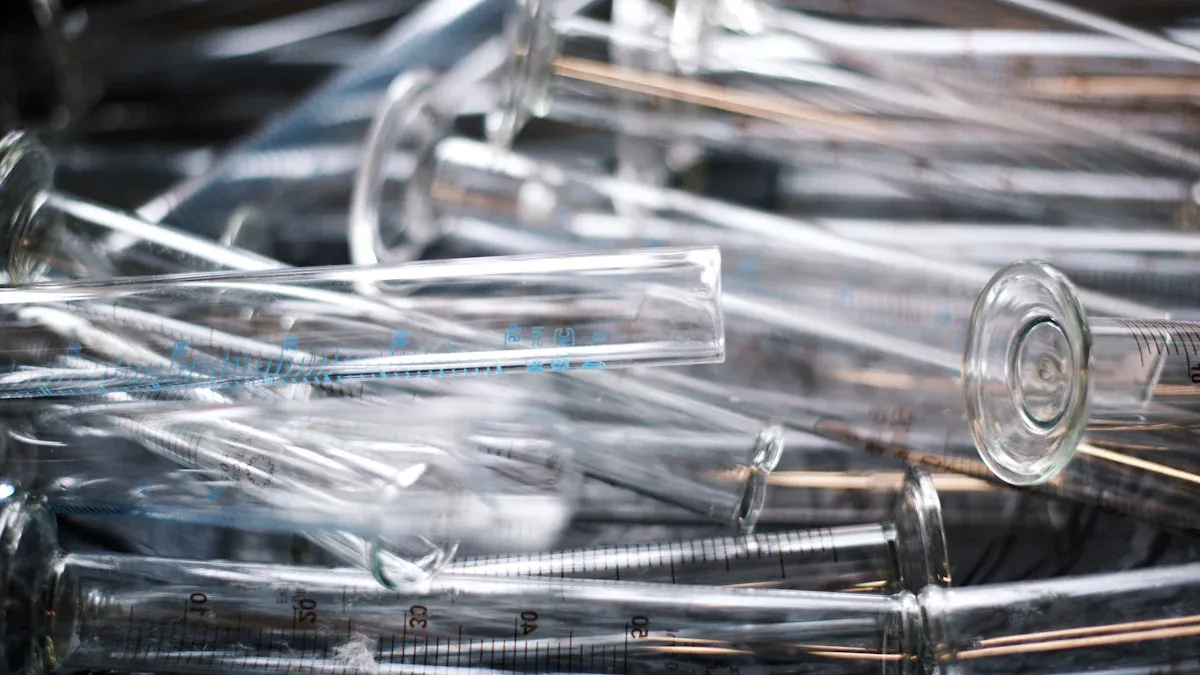How to Choose Polyimide Tubing with Low Friction Coating

Choosing the right polyimide tubing with low friction coating helps it work well. You should check if the tubing fits your project needs. Things like coating type, strength, and wear resistance are important. These features make the tubing last longer and work better. For medical tools or airplanes, good polyimide tubing with low friction coating reduces friction and works smoothly. Picking the right tubing saves money and improves results.
Key Takeaways
Pick polyimide tubing that matches your project's needs like strength and flexibility.
Coatings with low friction make tubing work better and last longer.
Check the tubing size and fit to avoid problems and improve reliability.
Test for heat and chemical resistance to ensure it handles tough conditions.
Buy from trusted suppliers who follow quality rules for strong, reliable tubing.
Understanding Polyimide Tubing with Low Friction Coating

What is polyimide tubing?
Polyimide tubing is a strong material used in many industries. It is made from polyimide, a polymer that handles heat, pressure, and chemicals well. This tubing is light but tough, so it works in hard conditions. Engineers like it because it performs well even in extreme situations.
Here are some important features of polyimide tubing:
Feature | Value |
|---|---|
Heat Rating for 20,000 Hours | At least 220 °C |
Heat Endurance | At least 400 °C |
Strength | At least 20,000 PSI |
Chemical Resistance | Excellent, resists most chemicals |
Thermal Expansion Rate | 4.0 X 10-5/°C |
These qualities make polyimide tubing a good choice for jobs needing heat resistance, strength, and chemical toughness.
Why add low friction coating?
Low friction coating makes polyimide tubing work even better. It lowers surface resistance, so fluids and parts move easily. The coating also reduces damage, helping the tubing last longer.
Studies show how useful this coating is:
It uses special fillers to reduce friction.
Tests prove it has less friction than Teflon.
It stays strong after UV light, heat, and moisture tests.
This coating helps in medical tools, airplanes, and machines. It makes them work better and need less fixing. Picking tubing with this coating means smoother and easier operations.
Key Considerations for Selecting Engineering Plastics
Application-specific requirements (e.g., medical, industrial, aerospace)
When picking engineering plastics, think about what your project needs. Different industries need materials with special features to work well. For example, medical tools need tubing that resists chemicals and is safe for the body. Machines in factories need strong plastics that can handle heavy use. Airplanes need light materials that stay strong in high heat.
Tip: Match the material's features to your project's needs. For example, airplane makers like polyimide tubing because it handles heat and stays strong.
Here’s how engineering plastics are used in different industries:
Segment | Key Insights |
|---|---|
Electrical & Electronics | Leads with 31% market share; used in advanced devices; growing at 8% yearly. |
Packaging | Big demand due to easy-to-use food packaging. |
Automotive | Uses lightweight plastics to save fuel. |
Building & Construction | Known for being strong and useful in many ways. |
Industrial & Machinery | Performs well in tough jobs. |
Aerospace | Lightweight and handles heat well. |
Knowing what each industry needs helps you pick the right plastic for your project.
Importance of tubing dimensions and tolerances
Exact sizes and limits are very important for tubing to work right. If tubing doesn’t meet the right size, it can cause problems or even break equipment. You should check the size, shape, and surface of the tubing. These things affect how well it works.
Why tolerances matter:
They help parts fit together perfectly.
They keep the tubing strong and long-lasting.
They make sure the tubing works well in different situations.
Design plans often show the needed tolerances for parts. For example, airplane parts need very exact sizes to stay safe and work right during flights. Picking tubing with the right size helps avoid mistakes and makes your system work better.
Evaluating temperature and chemical resistance
Heat and chemical resistance are key when choosing tubing. Polyimide tubing is great for high heat, working even above 220°C. It also resists chemicals, so it’s good for tough environments.
To check these features, look at test results and charts. For example:
Chemical | LDPE Resistance at 20°C | HDPE Resistance at 20°C |
|---|---|---|
1.4-dioxane | No damage after 30 days. | No damage after 30 days. |
Acetone | May cause damage. | May cause damage. |
Acetic Acid, glacial 50% | No damage after 30 days. | Damage happens quickly. |
Material | Properties | Chemical Resistance |
|---|---|---|
Butyl | Good against weather, blocks air well. | Bad with oil-based fluids. |
Chlorinated Polyethylene (CPE) | Lasts long in sunlight and weather. | Resists oil and chemicals well. |
EPDM | Good all-around material. | Great with heat, ozone, and weather. |
FKM | Handles high heat well. | Very good with chemicals. |
Note: Materials rated "A Excellent" are very strong, while "D Poor" means they get damaged fast. Always pick tubing that matches your environment.
By checking these things, you can make sure the tubing stays strong and lasts long, even in tough places.
Checking flexibility and durability
When picking polyimide tubing, check how flexible and durable it is. These two things show how well the tubing works under pressure and how long it lasts.
Flexibility means the tubing can bend or twist without breaking. This is very important for things like medical tools that need to move in tricky ways. Flexible tubing lowers the chance of cracks or breaks, even with repeated use. For example, in robots, flexible tubing helps parts move smoothly without extra stress.
Durability shows how well the tubing handles wear and tear over time. Polyimide tubing is very durable because it is strong and resists damage from the environment. Studies prove that polyimides, like BPDA-PPD, stay strong even in tough conditions. Tests in body-like settings showed BPDA-PPD tubing stayed stable for 20 months at 37°C in water or saline. Also, implanted electrodes made from this material worked fine after 12 months. These results show how reliable polyimide tubing is for important uses.
To check flexibility and durability, follow these steps:
Test flexibility: Bend the tubing to see if it moves without damage.
Check material details: Look for strength and stretch limits to know its stress capacity.
Check resistance: Make sure it can handle moisture, heat, and chemicals.
By checking these points, you can pick tubing that fits your needs and lasts a long time.
Exploring Types of Low Friction Coatings

Common coating materials (e.g., PTFE, silicone)
Low friction coatings help polyimide tubing work better. They make surfaces smoother and reduce resistance. Different coatings are used for various jobs. Each type has special features for specific industries.
PTFE (Polytetrafluoroethylene)
PTFE, also called Teflon, is very popular. It creates a slippery surface and resists chemicals well. PTFE is used in aerospace, cars, and food industries. It handles high heat and tough chemicals, making it great for hard tasks.
Fluoropolymers
Fluoropolymers are strong and smooth. They work well in chemical factories and manufacturing. These coatings last long and resist damage, even in harsh conditions.
Silicone
Silicone coatings are flexible and reduce friction. They are often used in seals and gaskets. Silicone stays strong in different temperatures, making it useful in many industries.
Here’s a simple comparison of these coatings:
Coating Type | Key Features | Uses |
|---|---|---|
PTFE | Slippery, chemical-resistant | Cars, planes, food tools |
Fluoropolymer | Durable, smooth | Factories, chemical plants |
Silicone | Flexible, low friction | Seals, gaskets |
Pros and cons of different coatings
Choosing the right coating means knowing its good and bad sides. This helps you pick the best one for your job.
Pros
PTFE is great because it doesn’t stick and resists chemicals. It works well in hot or corrosive places. Fluoropolymers are super strong, perfect for heavy-duty tasks. Silicone is flexible, which is good for tubing that bends a lot.
Cons
PTFE resists chemicals but isn’t as strong under pressure as fluoropolymers. Fluoropolymers are tough but cost more. Silicone bends well but doesn’t resist chemicals like PTFE or fluoropolymers.
Studies show how new coatings improve performance. For example:
Study Title | Results | Coating Type |
|---|---|---|
Wear Resistance of Aluminum/Quasicrystal Coatings | Better friction and less wear with hybrid coatings | Composite coatings |
Graphene Nanoplates-Inconel 718 Coatings | Added low friction materials improved properties | Inconel 718-graphene |
These studies prove advanced coatings can last longer and reduce friction. They offer new options beyond traditional materials.
Tip: Think about your environment and job needs when picking a coating. The right match ensures better performance and longer life.
By learning the pros and cons of coatings, you can choose the best one for your project.
Ensuring Compatibility and Quality Assurance
Steps to ensure compatibility with your application
To make sure polyimide tubing with low friction coating fits your needs, test it carefully. First, check how it reacts to chemicals it might face. Use chemical compatibility charts to spot any risks. These charts show how plastics handle different chemicals.
Then, do quick chemical resistance tests. Put the tubing in contact with the chemicals and watch for changes. This helps find materials that might fail fast. For long-term use, run Environmental Stress Crack Resistance (ESCR) tests. These tests show how the tubing holds up after long chemical exposure.
After testing, review the results. Label the tubing as "Resistant," "Limited Resistance," or "Not Resistant." Think about chemical strength, time of exposure, and temperature. This process helps you pick tubing that works well for your job.
Tips for testing and verifying product quality
To keep tubing quality high, follow strict quality checks. Manufacturers use many methods to make sure tubing and coating meet needs. Here’s a list of key methods:
Protocol | What It Does |
|---|---|
Six Sigma | Reduces mistakes by improving processes and training. |
ISO Standards | Sets rules for quality and safety. |
Supplier Audits | Checks if suppliers meet quality standards. |
Risk Assessment | Finds problems and fixes them using tools like FMEA. |
Statistical Process Control | Tracks production to catch and stop defects early. |
You can also test the tubing yourself. Look for even coating and correct sizes. Test how it works under heat, pressure, or chemicals. These steps make sure the tubing is right for your needs before using it.
Tip: Choose suppliers who follow strong quality checks. This ensures you get tubing that lasts and works well.
Sourcing High-Quality Polyimide Tubing with Low Friction Coating
Finding reliable suppliers and manufacturers
Getting polyimide tubing from a trusted supplier is very important. Good suppliers focus on quality and follow industry rules. They give clear product details and help meet your needs.
Check if the supplier follows important safety and quality standards. These rules make sure the tubing is safe and works well.
Regulatory Standard | Why It Matters for Polyimide Tubing |
|---|---|
REACH | Ensures safe use of chemicals |
RoHS | Limits harmful materials |
FDA | Approves for medical and food-safe uses |
Suppliers with ISO 9001 certification show they have strong quality control. This means their tubing is durable and works well in different jobs.
Tip: Pick suppliers like AccuPath. They provide top-quality engineering plastics that meet strict standards. Their products are reliable and fit your needs.
Important questions to ask before buying
Ask the right questions before buying polyimide tubing. This ensures it works well for your project. Start by checking if it can handle heat, chemicals, and wear.
Here are some helpful questions to ask:
Does the tubing meet safety standards like FDA or REACH?
How long will the tubing last in your application?
Can the supplier share quality control and testing reports?
Are there options to customize size or coatings?
These questions help you find tubing that fits your needs. Good suppliers will answer clearly and guide you to the best choice.
Note: AccuPath offers great support and high-quality engineering plastics. Their team helps you pick the right product for tough applications.
Picking the right polyimide tubing with low friction coating helps it work well for your needs. Match the tubing and coating features to your project’s requirements for the best results. Check what your project needs, like strength, bending ability, and resistance, before choosing. Asking experts can give helpful advice and prevent expensive errors.
Find reliable suppliers and test the tubing to make sure it’s good quality. This way, you’ll know the tubing will work as expected and last in its job.
FAQ
Why is polyimide tubing used in many industries?
Polyimide tubing is strong, resists chemicals, and handles high heat. These features make it great for tough jobs like in airplanes, medical tools, and machines. It works well even in harsh conditions.
How does low friction coating help polyimide tubing?
Low friction coating makes surfaces smoother for easier movement. It reduces damage and helps the tubing last longer. This is useful for precise tools like medical devices or airplane systems.
Can polyimide tubing with low friction coating handle heat?
Yes, it can handle very high heat. This makes it perfect for tough jobs in hot places, like factories or airplanes. It keeps working well even in extreme heat.
What are Vespel ferrules, and how do they work with polyimide tubing?
Vespel ferrules are strong parts made from a tough material. They seal well in high heat and pressure. When used with polyimide tubing, they make systems more reliable and efficient.
How can you check the quality of polyimide tubing?
Buy from trusted suppliers who follow strict rules like ISO 9001. Test the tubing for strength, flexibility, and chemical resistance. Make sure it fits your project’s needs before using it.
See Also
Selecting The Ideal Ultra-Thin PET Heat Shrink Tubing
Key Considerations For Selecting FEP Shrink Tubing
Guidelines For Picking The Right PTFE Etched Liner

